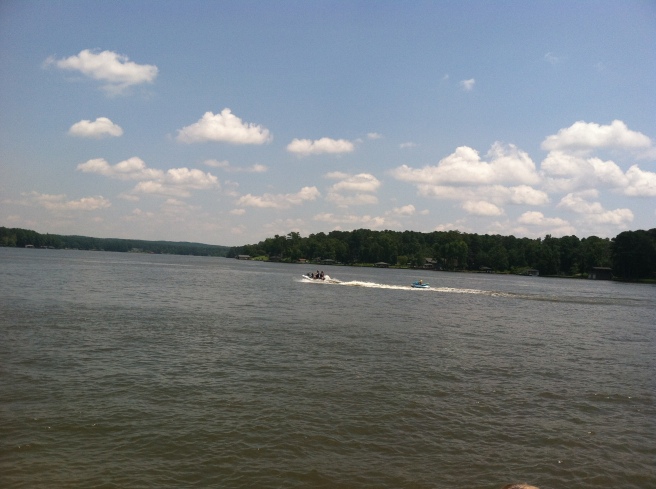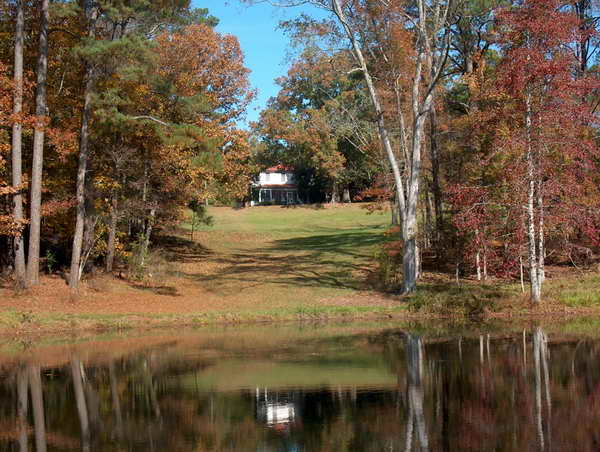(Based on a lecture presented at “Reason, Fiction and Faith: An International Flannery O’Connor Conference,” at the Pontifical University of the Holy Cross in Rome, Italy, April 20-22, 2009)
American author Flannery O’Connor completed the short story “A View of the Woods” in September 1956, three years after the major electrical utility company in Georgia finished construction of a dam on the Oconee River, which winds it way south through Baldwin County, Georgia, and cuts a path just east of downtown Milledgeville. There are interesting similarities between the circumstances in O’Connor’s short story and the developments that were taking place in the Milledgeville area where O’Connor was living when she wrote it. To some degree, O’Connor’s story envisions the rapid commercial and residential development that would eventually threaten the landscape of Andalusia, the family farm operated as a dairy in the 1950s by O’Connor’s mother, Regina Cline O’Connor.
Flannery O’Connor moved back to Milledgeville in 1951 from Connecticut, where she had been living with Robert and Sally Fitzgerald since September 1949. Andalusia is located directly on the north-south highway passing through Milledgeville, which was officially designated U.S. Highway 441 in December 1948. The dam on the nearby Oconee River created Lake Sinclair, covering over fifty square miles with approximately six hundred miles of shoreline in three different counties. Within a short time, residential development began to claim sections of the lake’s shoreline as families started investing in weekend cabins at first, followed by increasingly lavish permanent homes. Greater interest in lake recreation brought the construction of marinas, boat ramps, fishing supply stores, camping facilities, and parks. Highway 441 was the major artery connecting the town of Milledgeville with the growing lake community and points farther north with larger highways leading to the state’s capital, Atlanta.

Government officials and a good portion of the electorate across the rural American countryside in the 1950s and 60s were ravenous to “catch up” with the big cities and attract jobs, build infrastructure, and provide new and improved services to their communities. Milledgeville was no exception, and the creation of Lake Sinclair paved the way. Textile manufacturing plants began to move in during the late 1940s when construction of the dam was underway; the first drive-in theater opened in 1950; the local telephone company was purchased by an outside conglomerate to expand service in 1957, the year that “A View of the Woods” was published. In that same year, Milledgeville experienced its first modern expansion of the city limits, moving the northern boundary just a mile from the driveway to Andalusia.
Beginning in the first paragraph of O’Connor’s story, the reader is presented with circumstances that mirror Milledgeville’s mid-twentieth-century progress. After explaining the family dynamics that will ultimately drive the story to its shocking conclusion, the narrator provides details of the circumstances surrounding Mr. Fortune’s windfall. The power company’s dam floods much of the countryside, providing Mr. Fortune with lakefront property. He knows there will soon be commercial development, creating even greater demand for his land.
Mr. Fortune’s idea of improvement includes paved highways filled with new-model automobiles and flanked by supermarkets, gas stations, motels, and a drive-in theater. His vision is inspired by the success of a nearby entrepreneur identified as Tilman, whose very name invokes an inherent conflict in the story between plowing the land and manning the till or the cash box. Tilman’s eclectic country store is complete with a barbeque pit and is reminiscent of many establishments that populated rural highways in the United States sixty years ago, and in some areas, still exist today. In her story, “A Good Man Is Hard to Find,” O’Connor included a similar roadside establishment called The Tower, where Red Sammy Butts sold his famous barbeque in a combination gas station and dance hall.
In her typical fashion, O’Connor offers marvelous and visually descriptive language to profile her characters and to punctuate their traits. Tilman’s evil nature is clearly identified with an appearance that invokes mythological satanic images. Mr. Fortune’s deal with Tilman to sell the lawn that provides his daughter’s family with a view of the woods is an obvious reference to Faust’s pact with the devil from the classic German legend, an observation made in early critical works on O’Connor by Frederick Asals and other scholars. Like a demon being promptly transported back to hell after shaking Mr. Fortune’s hand on the transaction, Tilman slouches back under the counter.
O’Connor presents Mr. Fortune as an ambitious landowner, driven by pride and domination, whose hunger for progress and personal acclaim blinds him to the pure beauty of the natural world. Mr. Fortune’s canvas of the future is painted with deception, revenge, and even violence. The story pairs reckless commercial progress with greed and avarice, contrasting the irresponsible destruction of natural resources to the stewardship of preserving the rural landscape. In describing the disintegration of a cow pasture into a red-clay pit by the heavy machinery in the beginning of the story, O’Connor uses the words “disembodied,” “nausea,” and “revulsion,” analogous of an assault by a deadly disease or virus. Later in the narrative, Mr. Fortune envisions the woods and trees being drenched in blood from the wounded, barely visible sun setting behind them, the mysterious sacramental image that O’Connor repeated many times in her fiction.
The critical literature provides an abundance of commentary on the personification of landscape and the role of nature in O’Connor’s fiction, from Carter Martin to Christine Flanagan. We recognize that Mr. Fortune’s lack of apprehension is manifested in his inability to appreciate the mysteries of creation that literally surround him. The woods in this story provide a backdrop for a small sanctuary, “the lawn,” where the Pitts children can play in safety, a respite from the otherwise contentious and even threatening environment that is ever present. In a letter to Elizabeth Hester dated December 28, 1956, O’Connor made the analogy conclusively when she compared the woods to Christ. They seem to walk on water and are surrounded by light. O’Connor associates the forest with purity.
Mr. Fortune’s obsession with obliterating the pastoral setting and beginning construction of his commercial empire is a rejection of purity and an abuse of innocence, an evil intention that is also reflected in his disintegrating relationship with his granddaughter, Mary Fortune. He considers the child his protégé, or even a prized possession; however, his ambition goes too far when he announces his plans to destroy the lawn. As the tension grows to hostility between Mr. Fortune and the child, she calls him the “Whore of Babylon,” and indeed he has become a prostitute by selling off the family property. After all, he is “pure Fortune.” When the child becomes an obstruction to his strategic plans, his fixation turns to rage and results in the horrible murder of his granddaughter. The old man’s damnation is sealed.
To translate O’Connor’s theme in this short story as a summary condemnation on all commercial development would be a careless overstatement. Mr. Fortune’s daughter and son-in-law are by no means portrayed as altruistic or even humane. At the same time, the old man’s intentional conversion of land and trees to pavement and buildings, with total disregard to the desires of his family, characterizes him as irresponsible, if not evil. His hasty decisions and actions are illustrative of many mid-twentieth century landowners in America who sold property that had been in their families for several generations, placing their birthrights in the hands of developers who were delighted to build and pave over the woods and fields.
Many Americans, including elected officials, are starting to understand that unrestricted and mostly unregulated urban expansion has led to the destruction of the natural landscape that characterized rural America: the lawn where we play, where we graze our calves, and where we look at the woods from the porch, in Mary Fortune’s words. It is only in recent years that government agencies have started to encourage landowners to preserve their holdings, even providing tax incentives to keep land undeveloped.
Flannery O’Connor’s uncle, Dr. Bernard Cline, purchased the Andalusia property in the early 1930s and later acquired more land adjacent to the farm, which remained undeveloped for many years as a haven for wildlife. Such was not the case for so much of the land adjacent to Dr. Cline’s property. Perhaps it wasn’t O’Connor’s intention, but her story ends up being a prediction of the disappearance of the countryside that once surrounded Andalusia. Her forecast came true to some degree, with the eventual expansion of Highway 441 that carved away two acres of the east boundary of the family farm. The encroaching commercial development that followed was inevitable, including the Milledgeville Mall, which was constructed a mile south of Andalusia only eight years after O’Connor’s death. The next two decades would see the proliferation of fast-food and franchise restaurants, retailers, motels, convenience stores, car dealerships, nightclubs, and the king of capitalism, Walmart. The concentration of this rapid growth was located within a two-mile radius of Andalusia.

While opinions vary widely on what constitutes good stewardship of the land and protection of the environment, Andalusia’s caretakers have been able to take advantage of urban encroachment while still providing a view of the woods for the many visitors who have made their way to the property since it opened to the public in 2003. Although Milledgeville is in a very rural area of the state, Andalusia’s location on a U.S. highway brings travelers right to the driveway. Most American tourists reach their destinations in automobiles, and when they arrive, most of them expect accommodation and comfort. Abundant businesses within one mile of Andalusia’s entrance are more than capable of meeting the basic needs of travelers, including fuel, food, lodging, and entertainment. However, the farm structures of Andalusia are positioned a few hundred yards from the highway with a buffer of trees on all sides. This limited isolation allows visitors to make their way up the driveway to the main house, where their imagination can easily transport them back in time to 1964, as if Flannery O’Connor had just departed Andalusia for the last time.
Certainly, Andalusia is off the beaten path, and O’Connor’s readers who truly desire to experience the countryside that inspired some of her best fiction must leave the city and the interstate highways. The rewards for making that departure are certainly worth the effort. The current owner of Andalusia is Georgia College, the liberal arts institution in Milledgeville descended from O’Connor’s alma mater, Georgia State College for Women. I am hopeful and encouraged that the College is committed to preserving the view of the woods at this internationally significant landmark, a proper memorial to such a gifted writer.



A terrific and informative read — thank you!
LikeLike
Thanks so much.
LikeLike